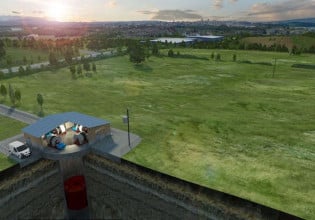Profile: NREL’s Genevieve Starke Talks Wind Models, Role Models
Genevieve Stark plans the future of wind energy as a research engineer with the National Renewable Energy Laboratory. Recently, she told EEPower about her role, her goals, and the women who mentored her along the way.
Mechanical engineer Genevieve Starke works at the cutting edge of renewable energy. As a researcher with the National Renewable Energy Laboratory (NREL), Starke spends her days modeling how wind energy works with other technologies in hybrid systems.
Hybrid energy integrates renewable energy sources and technologies into a comprehensive system.
“I think of it as combining different technologies together, so they work together,” Starke told EEPower. “I come from a wind background, so the majority of my work is combining other technologies with wind, mostly battery storage, solar, and hydrogen.”
NREL engineer Genevieve Starke researches renewable energy models. Image used courtesy of NREL
Starke now works for NREL’s National Wind Technology Center in Colorado. However, as a high school student, she did not envision she would end up researching renewable energy sources.
“I went into engineering mainly because I’ve always been interested in solving puzzles, so that side of engineering appealed to me,” Starke explained.
Once in college, she met other engineers, including women engineers, who influenced her path toward wind energy research.
Engineering: “An Amazing Feeling”
In her undergraduate in aerospace engineering at Syracuse University, Starke felt challenged because she didn’t have a strong background in math.
The summer after her sophomore year, she participated in a summer engineering program with research opportunities. She wrote up the results and presented them at a symposium, which she said gave her “an amazing feeling.”
Though she had discovered a passion for research, she had no ambitions other than to earn her bachelor’s degree and get a job. Then, she met a woman faculty member, Melissa Green (now at the University of Minnesota), who encouraged Starke to go to graduate school.
“That was really impactful, seeing a woman in that role and being successful at it. It was really important to me because I don’t think I would have considered it if someone hadn’t told me that I could do it.”
Her educational experience led to master’s and doctoral degrees in mechanical engineering from Johns Hopkins University.
Starke also had women mentors in graduate school, and one of them introduced her to Jennifer King, a research engineer at NREL. The meeting led Starke to her present role at NREL.
For Starke, seeing women in engineering and leadership roles was essential.
“Representation was really, really instrumental in my trajectory,” Starke said.
Modeling Renewable Energy
As a computational researcher, Starke uses and develops models for energy technologies.
“I’m usually working on maybe four to six different projects at a time, so there are project updates and coding that I do,” Starke explained. “There’s also some writing and presenting mixed in, which is how researchers communicate.”
Starke using NREL models for researching wind energy systems. Image used courtesy of NREL
Starke said she didn’t anticipate how important communication skills would be for her job.
“There are written slides and meetings, and that’s a pretty huge part of what we do because we work with a lot of different collaborators like other national labs,” she said. “We work with the Department of Energy, international labs, and international agencies, so coordinating all of those takes a lot of communication.”
Starke said her lab publishes information others can use in their studies.
Ultimately, Starke’s goal is to help the transition to renewable energy.
“I hope that I can further the holistic study of energy and bring different technologies and different disciplines together,” Starke said. She added that she wants to facilitate communication between the technologies and those working with them.
Inspiring the Next Generation of Engineers
Starke advised aspiring engineers not to worry if they lack a strong background in engineer-related courses or experiences. She mentioned that although she had only taken a couple of formal coding courses, she had continued to learn on the job.
“I think what’s most important is to keep showing up,” Starke said. “What’s enabled me to be successful is persistence.”
Interest and determination will keep you going in engineering, she said.
“I would also say that along the way, you’re probably going to feel like you don’t fit in somewhere, and that’s OK,” she said. “I think everyone feels that a bit.”








